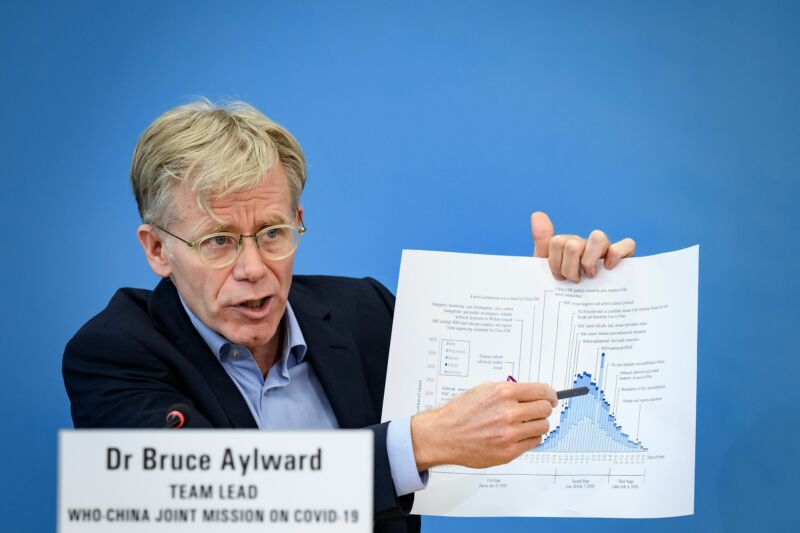CDC tells Americans to brace for coronavirus
WHO's insights from China suggest that the virus can be contained.

Enlarge / Team leader of the joint mission between World Health Organization (WHO) and China on COVID-19, Bruce Aylward shows graphics during a press conference at the WHO headquarters in Geneva on February 25, 2020.
Fresh off a plane from China, epidemiologist Bruce Aylward sat before members of the press at the World Health Organization’s headquarters in Geneva, Switzerland on Tuesday and laid out key insights from the coronavirus front lines.
He pointed to humped graphs of cases over time—they are the shape of an epidemic that has been hobbled, he said. Disease spread has been in decline since the beginning of the month, and doctors in China are honing their ability to treat patients. “If I had COVID-19, I’d want to be treated in China,” he said candidly.
Based on the data, China’s massive efforts have been generally successful and indicate that the virus can be contained, Aylward reported. Yet Chinese officials remain vigilant, he added, in case this never-before-seen virus (which has plagued humanity for mere weeks) presents any surprises.
While Aylward was impressed with the Chinese government response, he noted early in the briefing that he was also taken by the response of Chinese citizens—their cooperation and individual sense of duty to try to help quash the outbreak. “We spoke to hundreds of people... and they all shared this sense of responsibility, accountability to be part of this,” Aylward said, noting that there didn’t appear to be any government pressure or presence forcing that sense of duty. People were adhering to quarantine protocols on their own, he noted, and medical staff were volunteering to go to the hardest hit areas in the Wuhan province.
“Every person you talk to there has a sense that they’re mobilized, like in a war against this virus,” Aylward said.
Call to war
The significance of that solidarity and cooperation was not lost on officials in the United States. Just as Aylward was making his remarks in Geneva, officials thousands of miles away at the US Centers for Disease Control and Prevention were making their own wartime rallying cry.
In a press conference Tuesday, Dr. Nancy Messonnier, director of the CDC’s National Center for Immunization and Respiratory Diseases, said that the American public and businesses should prepare for the possibility that the new coronavirus will spread in the US.
Given the rapid increase of COVID-19 in other countries outside of China in recent days, “we expect we will see community spread in this country,” Messonnier said. “It’s not so much a question of if this will happen anymore, but rather more a question of exactly when this will happen and how many people in this country will have severe illness.”
Parents should talk with schools and daycares about outbreak responses and closure plans, and they should ask about tele-school options, she advised. Companies and employees should think about remote working arrangements and alternative childcare. And people should look into the availability of tele-medicine options with their healthcare providers.
“I had a conversation with my family over breakfast this morning,” Dr. Messonnier said. “I told my children that, while I didn’t think they were at risk right now, we as a family need to be preparing for significant disruption of our lives.”
Practical measures
In the event of community spread of the virus, additional measures might also take effect, such as cancellation of mass gatherings, extra sanitation measures, and the delay of elective medical procedures.
As always, people should be following good hygiene measures, including washing hands frequently and rigorously, covering coughs and sneezes, staying home when sick, and getting a flu shot.
In terms of preparation that public officials should be doing to prepare, Aylward said there were key takeaways from China’s successful responses. “There are really practical things” to prepare, he said, such as making sure that hospital beds are available, isolation measures are in place, health facilities have adequate amounts of ventilators and oxygen, and public health workers are ready to trace contacts of new cases as they’re identified.
Aylward also noted that based on the large amount of disease screening that’s been done in China so far, there does not seem to be a huge number of mild cases that are going undetected. And while asymptomatic spread of disease may happen, it does not seem to be a driver of the outbreak, he said. This assessment may dampen concern that the virus will become a pandemic by spreading widely in communities from unrecognized asymptomatic or mild cases. So far, household-level transmission appears to be the main driver of the outbreak, he said.
As of Tuesday, the COVID-19 outbreak has reached more than 80,300 cases worldwide, with 2,704 deaths.
No comments:
Post a Comment
Comments always welcome!